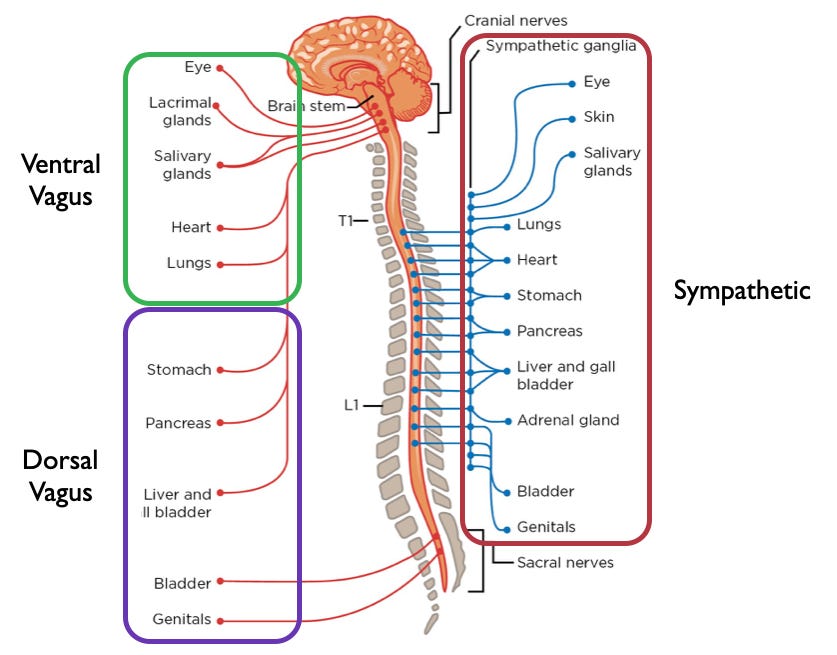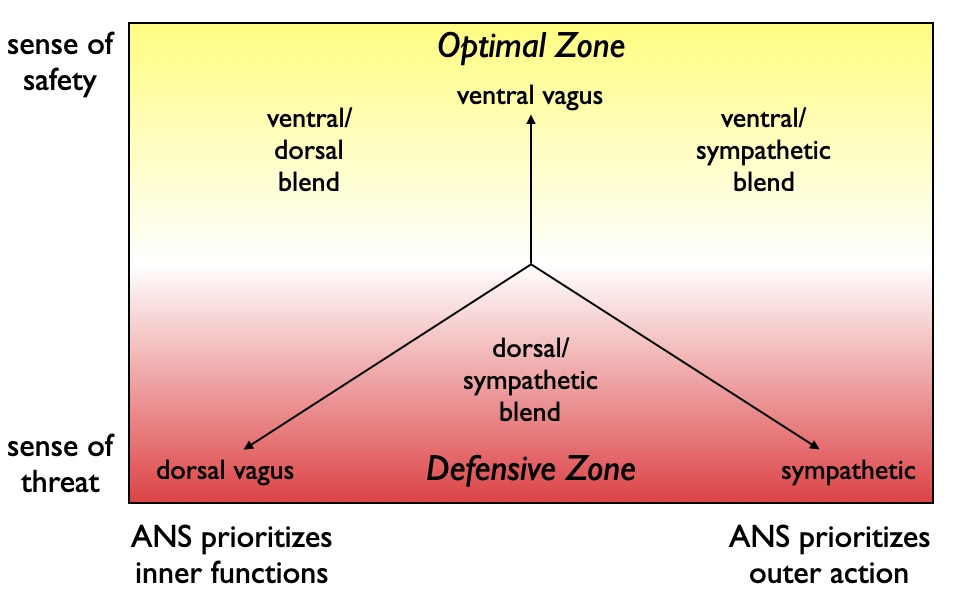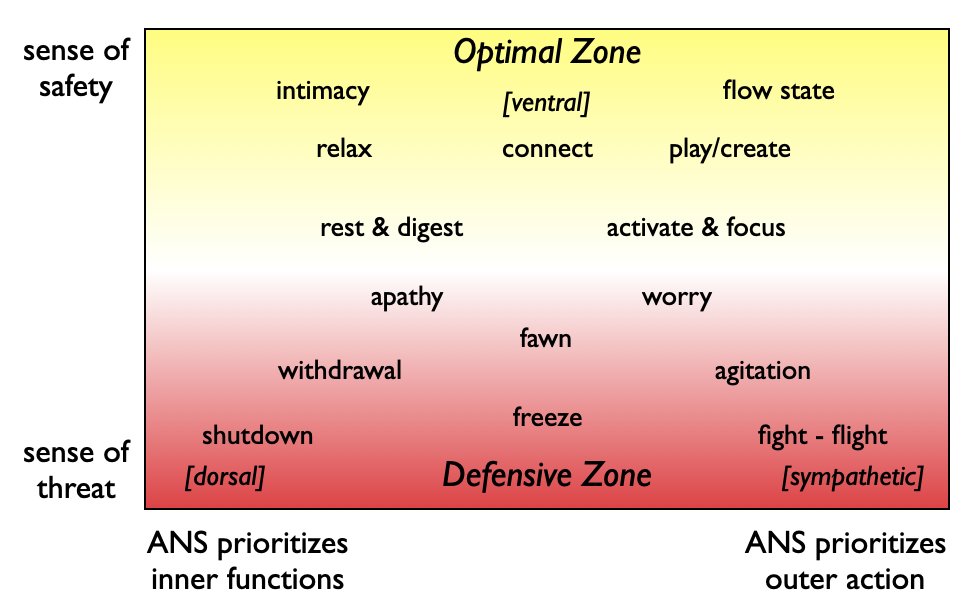Your Optimal Zone
This post is part of a pair that focuses on your Optimal Zone. This one provides a framework for understanding this incredibly important aspect of our human operating system, an aspect that affects how you experience and navigate every moment of your life. The next post, Optimal Zone Resilience, will build on that understanding and provide practices so that, when you get triggered out of your Optimal Zone, you can find your way back in a healthy, skillful way.
Optimal Zone and Defensive Zone
Optimal Zone is the term I use to describe a group of inner cognitive, emotional, neurological and somatic states that emerge naturally when you feel safe. You are likely to feel qualities such as curiosity, calm, clarity, connection, confidence, courage, creativity and compassion1. In it, you have increased capacity for complex thinking and accurate perception. It's the place where you are most meaningfully productive. In short, it's where you can enjoy life and accomplish what you care about.
It has a counterpart that I call the Defensive Zone, which is a different group of inner states that emerge naturally when you feel threatened. Your experience of the threat may trigger the urge in you towards fight or flight, or it may trigger feelings of depression and discouragement. Which way you go depends on the specifics of the threat and on your underlying life experiences.
It's important to note that ‘safety’ and ‘threat’ here are all about how you perceive the situation.
Understanding these two zones and the dynamics between them is a cornerstone for humanOS literacy and the foundation for many of the life-skills that are part of the Essential Capabilities.
Let’s take a deeper look at these two zones and why they are so significant for our inner experiences.
Autonomic Nervous System
The Optimal and Defensive Zones are most easily understood through the lens of the Autonomic Nervous System (ANS). In turn, the ANS's underlying story ties back to how animals evolved to function and survive in a complex world that included threats. There is evidence of the beginnings of the ANS in the fossil record going back at least 500 million years – over 2,000 times the span that humans have been around. The ANS is much more ancient than we are!
Its overall role is to regulate bodily functions like breathing, heart rate and digestion, without needing to depend on the conscious mind. The ANS is also centrally involved in both threat detection and threat response.
Fast-forward to humans in the present and the ANS, as it wanders throughout the body, looks like this:
It's helpful to distinguish three main parts:
The ventral vagus branch – When this branch is more active, you have better access to the Optimal Zone qualities I described above. When it's less active, you are more likely to experience the threat-related qualities of either the dorsal vagus or sympathetic branches. It primarily connects to organs above the diaphragm and that makes it the part of the ANS that can be most easily influenced by intentional actions like conscious breathing and smiling. It also supports and is activated by positive social engagement – everything from hugs to good conversation and companionship.
The dorsal vagus branch – When this branch is more active, it orients the body to internal functions, like digestion and rest. In a safe situation, it feels mellow and tranquil. In a threatening situation, it can lead to withdrawal, depression and even shutdown. It decreases muscle tone, focus and alertness, slows thinking and can impair memory. It shifts the blood flow toward the internal organs away from the muscles and brain. It primarily connects to organs below the diaphragm although it has some connections above, primarily related to evolutionarily-older homeostasis functions.
The sympathetic branch – This branch orients the body to outward action. It increases heart rate and breathing, shifts blood flow from internal organs to muscles and brain and promotes the release of adrenaline, cortisol and nor-adrenaline. It focuses and narrows attention, speeds up reaction times and leads to more black-and-white, categorical thinking. It's associated with fight-or-flight survival responses but the outer action doesn’t need to be that dramatic. It's also active when we play or are exploring with curiosity.
The ventral vagus and the dorsal vagus together have traditionally been known as the parasympathetic branch but they have separate anatomic and functional characteristics. Distinguishing them, as pioneered by Stephen Porges’ Polyvagal Theory, provides many helpful insights.
Every organ gets input from both the parasympathetic and the sympathetic sides, which tend to counterbalance each other as they adjust to support homeostasis and in response to changing situations.
The Optimal Zone/Defensive Zone diagram
There's a lot going on here and trying to understand all the permutations can seem awfully complex. Fortunately, we can tame that complexity with the help of a diagram that represents the whole territory of ANS states and allows us to connect whatever we're feeling (or have felt) with specific ANS states.
The inner functions vs. outer action continuum running along the bottom and sense of safety vs. sense of threat continuum running along the side are about our felt sense, about what we experience. The words inside show how that felt sense maps to ANS states.
The three lines represent situations where one of the branches is purely dominant. The space between them is for blends. The further away from the center along the line, the stronger the dominance of the branch. Off the lines, the further away from the line, the less that branch contributes to the blend.
The underlying diagram can be used as a background to display many things. For example, we can use it to display where various feelings and activities can be associated to locations on the diagram:
We don't have the empirical tests for the two axes to do the placement precisely but we can develop a level of self-awareness that allows us to usefully place any one of our experiences and see it in the context of the rest of the ANS states.
It's important that everything here is meant to allow smooth, continuous change from one location to another. There are no categorical boxes in the diagram. Any spot can be associated with an appropriate psychological state and contrasted with another spot, even if their difference is only a matter of degree. Even the Optimal Zone and the Defensive Zone blend into each other in the middle and become more intense toward the edges. This allows a more nuanced match between the concepts and our actual experience.
Your inner ANS state is fluid, evolved to help you survive, connect and thrive. It can change from moment to moment, as needed, and thus move you to any other location in the ANS territory. Indeed, every moment of your life is colored by your dynamic ANS journey. The ANS states you travel through are absolutely central to your experience of life. The goal of Optimal Zone Resilience, which I’ll cover in the next post, is to learn how to navigate these shifts with as much awareness and skillful influence as possible.
Using this diagram to understand how your experience connects to ANS states is a great example of the benefit of the Essential Capability of using diverse modes of cognition. It allows you to take what seems complex using language and categories and make it more understandable with a visual. Being able to see the territory of ANS states as a whole keeps you in touch with the big picture, allowing you to map what you’re feeling and chart your path towards a more desirable state.
The uniqueness of this approach
Overall, most of the approaches to the ANS are oriented to the therapeutic world, especially for trauma therapy. The approach I'm using here, in contrast, is intended to support life-skills that everyone needs and to serve the overall goals of personal and cultural change that I describe in the Foundational Keys.
My use of the terms Optimal Zone and Defensive Zone comes from my synthesis of my ongoing research and my direct experience, drawing on emerging concepts in neuroscience, especially as they relate to the perception of safety and threat.
The OZ/DZ diagram grew out of my desire to create a more whole-system representation of how we experience ANS states as a continuous territory rather than as distinct categories. It contrasts with visuals like Siegel’s Window of Tolerance, Stephen Porges’s ANS States diagram and Deb Dana’s Polyvagal Ladder, each of which have proven their value in other settings but don't have features that I've felt were important to include in the OZ/DZ diagram.
I was curious about how others might be using the terms Optimal Zone and Defensive Zone for groups of ANS states and so did some AI research. Optimal Zone gets some mention in sports psychology and in conjunction with Dan Siegel's Window of Tolerance. That's not quite the same as my usage, but I can understand the association. In any case, the AI chatbots guessed a meaning for Optimal Zone that is consistent with my usage.
The same AI chatbots weren't aware of any usage of Defensive Zone in contrast to Optimal Zone but they again guessed a meaning for it that is consistent with my usage.
In a follow-up post, I'll build on this one and look at what I call Optimal Zone Resilience. This helps us understand what happens when we get triggered into our Defensive Zone and how we can then move back towards our Optimal Zone in a healthy, skillful way.
I’ve borrowed the “8 c’s” from Richard Schwartz who uses them to describe what he calls the “Self” in Internal Family Systems. There are differences between the IFS Self and who you are when you’re in your Optimal Zone but the 8 c’s provide a lovely point of convergence.





Thinking about this today I was reminded of Danger Zone, a popular song from the 80s with the lyrics, "Highway to the danger zone!" We need a new one that goes, "Bike path to the optimal zone!" 😄